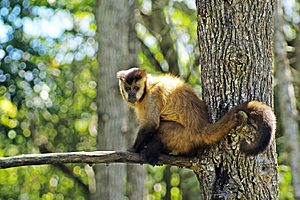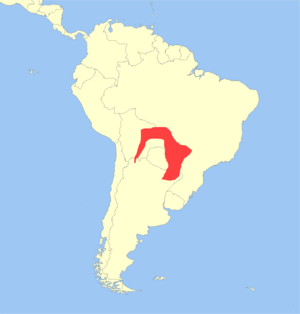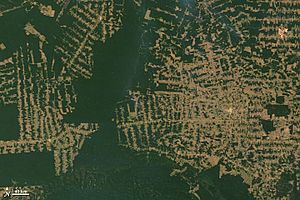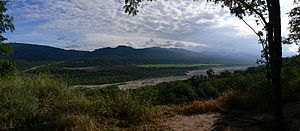Azaras's capuchin facts for kids
Quick facts for kids Azaras's capuchin |
|
|---|---|
 |
|
| Azaras's capuchin in the Pantanal, Brazil | |
| Conservation status | |
| Scientific classification | |
| Genus: |
Sapajus
|
| Species: |
cay
|
 |
|
| Range | |
| Synonyms | |
|
|
The Azara's capuchin or hooded capuchin (Sapajus cay) is a type of capuchin monkey. You can find them in eastern Paraguay, southeastern Bolivia, northern Argentina, and in the Mato Grosso do Sul and Mato Grosso states of Brazil. They live in warm, wet forests, especially in the Pantanal region.
These monkeys mostly eat fruits and insects. They also enjoy seeds, spiders, frogs, and even small mammals. Scientists once thought the Azara's capuchin was a type of black-striped capuchin. However, now it is seen as its own separate species.
Contents
About Azara's Capuchins
Scientists have studied capuchin monkeys for a long time. They found that there are two main groups of capuchins: Cebus (gracile capuchins) and Sapajus (robust capuchins). The Azara's capuchin belongs to the Sapajus group.
These two groups of monkeys separated about 6.2 million years ago. This happened because the Amazon River formed. The Cebus monkeys moved north into the Amazon rainforest, and the Sapajus monkeys moved south into the Atlantic Forest. Later, the Sapajus monkeys also moved north into the Amazon, so both groups now live in some of the same areas.
Scientists group Sapajus species into three main types based on where they live. The Azara's capuchin is part of the group found in central South America.
What They Look Like
Azara's capuchin monkeys are known as "tufted capuchins." This means they have a tuft of hair on their heads, which grows fully when they become adults.
Female capuchins are ready to have babies around 4 to 5 years old. Males are ready later, at about 8 years old. In zoos, these monkeys can live up to 50 years! In the wild, they usually live for about 30 years.
Males are a bit bigger than females. Females weigh between 1.4 to 3.4 kilograms (about 3 to 7.5 pounds). Males can weigh between 1.3 to 4.8 kilograms (about 2.8 to 10.5 pounds). An average male is about 0.8 meters (2.6 feet) long from nose to tail. Their tails are very long, sometimes half the length of their body.
These monkeys have medium-length fur that comes in different shades of brown. Their arms and legs are usually darker. They also have a dark stripe of hair in front of their ears, which looks a bit like sideburns. The way they look can change a lot depending on their age and where they live.
Daily Life and Behavior
Azara's capuchins are active during the day. They are omnivores, meaning they eat many different things. They live in social groups and travel around their territory looking for food. They spend most of their time resting, traveling, and searching for food.
What They Eat
Male capuchins often spend more time on the ground, resting and watching their surroundings. Females, however, spend more time in the trees, looking for and eating food. This is because males tend to eat bigger things, like larger fruits or even small animals. Females eat smaller meals, so they need to spend more time finding food to get enough.
Their diet mostly includes fruits, then seeds. Other plant parts and insects make up the rest of their meals.
How They Live in Groups
The size of Azara's capuchin groups can be very different. Some groups have fewer than 12 monkeys, while others can have up to 44! These groups have many males and females. There is usually an "alpha male" who is the biggest and strongest. This alpha male protects the group, controls who gets food, and is usually the first to mate with females.
These groups usually stay within their own territory. They only explore new areas if they absolutely have to, like during a big food shortage. These monkeys are very smart and can remember things for a long time. This helps them find food and avoid danger. For example, they can figure out that if one fruit tree is ready, others of the same kind nearby might be too.
Other Interesting Behaviors
Azara's capuchins have some unique behaviors. Some monkeys have been seen rubbing leaves from citrus trees on their fur. They might do this when they feel threatened. The strong smell of the leaves could be a way to protect themselves.
They also use tools! Even though they don't love eating hard-shelled fruits and seeds, they do eat them. These capuchins will hold the fruit with both hands and smash it against tree branches, using the branch like an anvil. Older, higher-ranking monkeys are very good at this. Younger or lower-ranking monkeys sometimes wait for the leftovers.
Where They Live
Capuchin monkeys live in the tropical and subtropical forests of South America and Central America. Azara's capuchins live in a wide area, but their populations are found in specific places. They live in hot, humid places with lots of rain and plants. They are very adaptable and can live in many different habitats, including bush lands and savannas.
You can find Azara's capuchins in northern Argentina, southeastern Bolivia, and eastern Paraguay. In Brazil, they live southwest of the Amazon, in the states of Mato Grosso, Mato Grosso do Sul, and southeast of Goiás. In Argentina, they are found in the provinces of Jujuy, Salta, Formosa, and Chaco. The Azara's capuchin is the only type of Sapajus monkey found in Paraguay.
Dangers and Threats
In Paraguay, there are not many major threats to the Azara's capuchin. Some local people hunt them for food, but not enough to cause a big problem. The main danger in Paraguay is the loss of forests due to human activities or natural disasters. Many people in Paraguay keep Azara's capuchins as pets, which helps raise awareness about protecting them.
However, in Brazil, the Azara's capuchin is considered highly vulnerable. They face many serious threats. These include fires, new towns and farms, logging, and roads being built. Their habitats are shrinking and becoming separated. Pollution, hunting, and being captured for the pet trade are also big problems.
In Argentina, the Azara's capuchins are also in danger. Their forest homes are being changed or destroyed for farming. Illegal hunting is another serious threat. All these changes can make the monkeys sick and increase their death rate.
Protecting Azara's Capuchins
In Brazil, scientists haven't studied the Azara's capuchin very much. This means it's hard to know the best ways to protect them. The species is in danger of extinction, so strong conservation efforts are needed.
In Argentina, Azara's capuchins are protected in several areas:
- El Rey National Park (44,162 hectares)
- Calilegua National Park in Jujuy Province (76,000 hectares)
- Baritú National Park (72,000 hectares)
In Bolivia, they are protected in Kaa-Iya National Park.
In Brazil, they are protected in many parks and reserves, including:
- Pantanal Matogrossense National Park
- Serra da Bodoquena National Park (77,021 hectares)
- Rio Negro State Park (7,000 hectares)
- And many other smaller private reserves.
See also
 In Spanish: Mono capuchino de Azara para niños
In Spanish: Mono capuchino de Azara para niños






